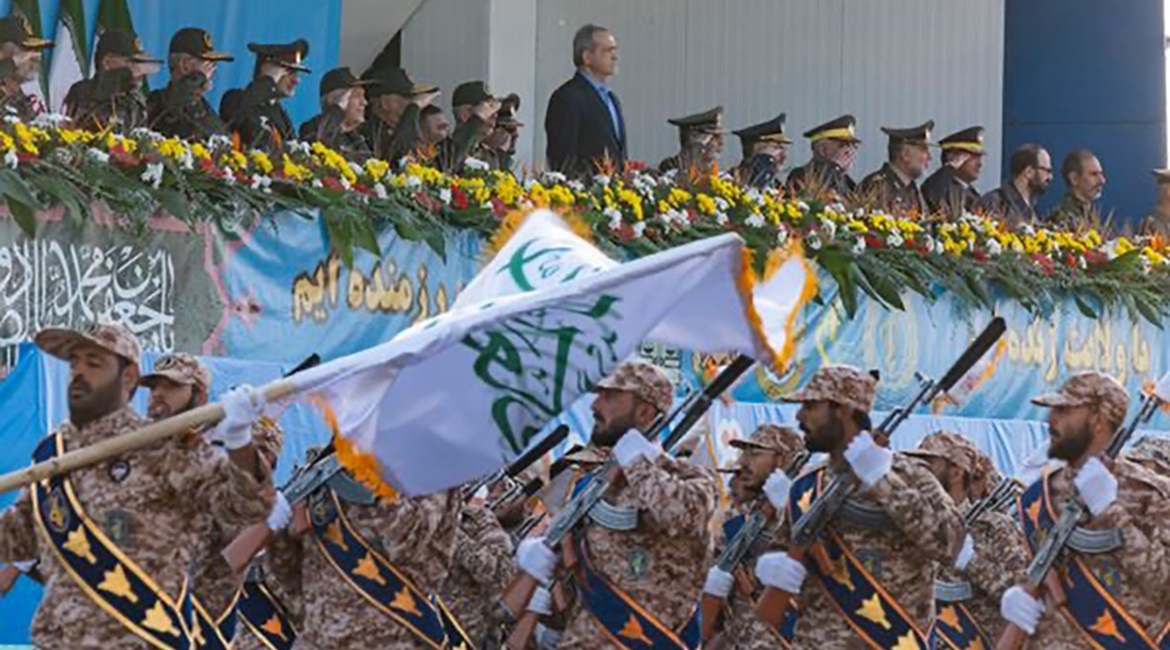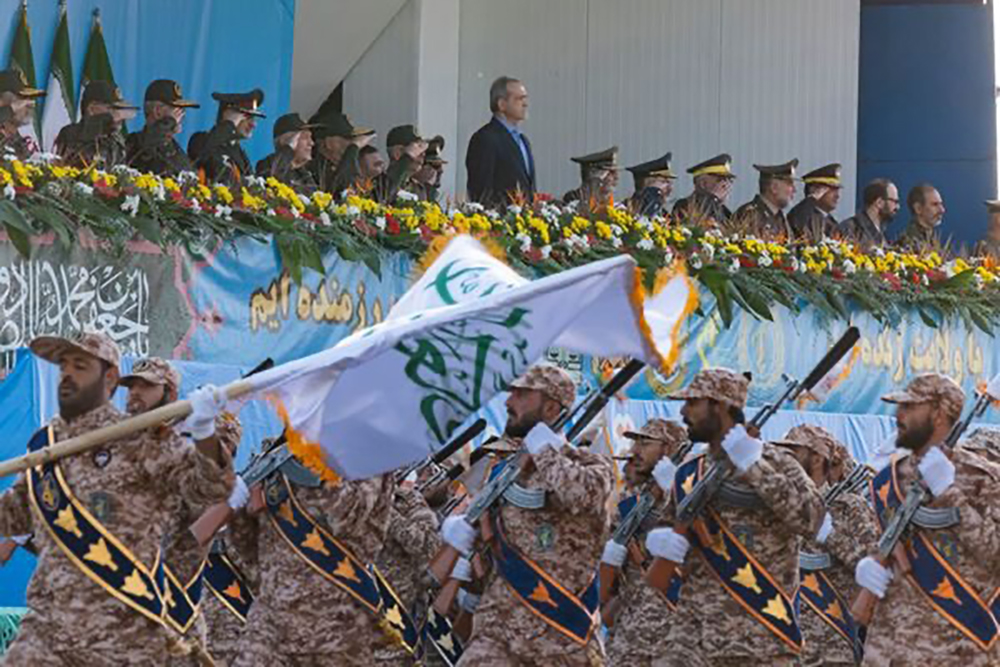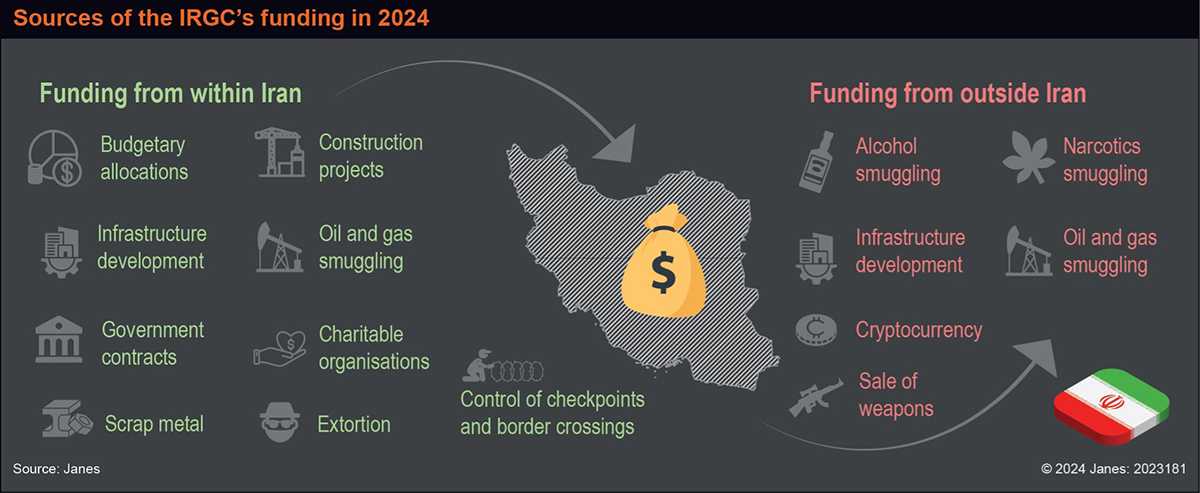
Date Posted: 25-Sep-2024
Author: Anant Venkatesh, Bangalore
Iran's Islamic Revolution Guard Corps (IRGC) remains among the most influential actors determining Iran's political stability and foreign policy, as well as the broader security landscape in the Middle East. Anant Venkatesh analyses the sources of the IRGC's funding to understand how this influences the organisation's objectives and capabilities and how sustainable these finances are in the medium to long term
Key points
- Intelligence question: What are the sources of financing of the IRGC, and how sustainable are they in the medium to long term?
- Significance: The IRGC's military capabilities, responsibilities, deployments abroad, and sway over the country's elections and foreign policy have overshadowed Iran's conventional armed forces since the 1979 Iranian Revolution. It remains a key player in determining Iranian political stability and the security landscape in the Middle East in 2024
- Assessment and outlook: Janes assesses with a moderate degree of confidence – due to a lack of diverse data sources – that the IRGC's sources of funding, as of 2024, are unlikely to be significantly weakened, either by internal or external contingencies and political considerations in the medium to long term
Introduction
The Islamic Revolution Guard Corps (IRGC) was set up as a separate arm of Iran's armed forces on the orders of former Supreme Leader Ayatollah Ruhollah Khomeini following the Iranian Revolution on 5 May 1979.
Mirroring Iran's conventional armed forces [the Islamic Republic of Iran Air Force (IRIAF), the Islamic Republic of Iran Army (IRIA), and the Islamic Republic of Iran Navy (IRIN)], the IRGC is further divided into the IRGC Aerospace Force (IRGCAF), the IRGC Ground Forces (IRGCGF), and the IRGC Navy (IRGCN). The IRGC also possesses two other divisions: the Basij, a paramilitary volunteer militia, and the IRGC-Quds Force (IRGC-QF), which serves to further Iran's strategic objectives abroad, including by co-ordinating with non-state armed groups (NSAGs).
Unlike Iran's conventional armed forces, which serve a more traditional military role pertaining to preserving the country's sovereignty and territorial integrity, the IRGC is primarily tasked with ensuring the survival of the political system specifically set up following the revolution. This is evidenced by Article 2 of the IRGC's constitution, which states that the corps serves to combat “factors and trends that aim to sabotage and overthrow the Islamic Republic of Iran, or act against the Islamic Revolution of Iran”.
The IRGC also holds significant sway over Iran's foreign policy formulation, its elections, and its economy by means of the networks of patronage it commands. Financially, the IRGC has consistently received a higher budgetary allocation from Tehran compared with Iran's conventional armed forces (see below) and is far better equipped in terms of its core assets as a result despite comprising less than a third of the 418,000 total personnel in the IRIAF, IRIA, and IRIN, according to Janes data.
As of 2024 Canada, Saudi Arabia, and the United States are among the countries that designate the IRGC as a “terrorist” organisation. The IRGC's access to international markets is consequently curtailed by several rounds of sanctions owing to its perceived destabilising activities, especially in the Middle East.
 Iranian President Masoud Pezeshkian stands at attention while armed military personnel from the Islamic Revolution Guard Corps march during a military parade commemorating the anniversary of the Iran-Iraq War (1980–88) outside the Khomeini shrine in the south of Tehran, Iran, on 21 September 2024. (Morteza Nikoubazl/NurPhoto via Getty Images)
Iranian President Masoud Pezeshkian stands at attention while armed military personnel from the Islamic Revolution Guard Corps march during a military parade commemorating the anniversary of the Iran-Iraq War (1980–88) outside the Khomeini shrine in the south of Tehran, Iran, on 21 September 2024. (Morteza Nikoubazl/NurPhoto via Getty Images)
Sources of funding
According to a December 2020 report by IranWire, a UK-based media outlet, Iran's 2021–22 budget allocated approximately USD2.3 billion to the IRGC, “representing almost a third of all funds designated for the country's defence purposes”. The report added that the amount was “almost three times the budget allocated for Iran's conventional armed forces”.
Data from Janes Defence Budgets largely supports this estimation , stating that Tehran has increasingly allocated part of its annual defence budget to the IRGC, from 27% in 2013 to 37.3% in 2023.
Other open-source estimates of Tehran's annual budgetary allocations to the IRGC range from USD2 billion, according to a December 2020 report by Iran Primer, a website affiliated with the United States Institute of Peace (USIP), to approximately USD7 billion, according to a June 2020 report by the Eurasia Group, a US-based private company.
Unlike Iran's conventional armed forces, the IRGC has also periodically received additional funds from Tehran during periods of heightened tensions with its adversaries. For example, Tehran provided the IRGC with approximately USD225 million following the US assassination of IRGC-QF commander Qassem Soleimani in January 2020 as part of what it termed “countermeasures against the US”, according to a report from the same month by the state-run Islamic Republic News Agency (IRNA).
Janes assesses that the IRGC's military and non-military capabilities almost certainly signify that such budgetary allocations from Tehran are heavily augmented by several other sources of funding, including illicit ones. These additional sources of funding can be divided into those from within Iran and those involving other states and/or foreign non-state actors.
Domestic sources
Khatam al-Anbiya
One of the primary methods by which the IRGC generates revenue domestically is through the activities of commercial entities that serve as fronts. Foremost among these entities is Khatam al-Anbiya, an IRGC-affiliated engineering firm, set up in 1979, responsible for projects in the country's agriculture, industry, hydrocarbon, health, real estate, mining, pharmaceuticals, roadbuilding, education, and transportation sectors.
According to a 2009 publication by RAND Corporation titled The Rise of the Pasdaran: Assessing the Domestic Roles of Iran's Islamic Revolutionary Guards Corps, Khatam al-Anbiya and/or its subsidiaries have been responsible for the construction of the Tehran-Tabriz railway line, the Karkheh dam in Khuzestan province, and a 900 km natural gas pipeline from Asaluyeh in Bushehr province to Iranshahr in Sistan and Balochistan province, among other projects. Additionally, Khatam al-Anbiya is also in charge of the operations of Imam Khomeini International Airport in Tehran.
The Tehran-affiliated Iranian Students' News Agency (ISNA) reported in September 2024 that Khatam al-Anbiya has also been responsible for the construction of several Iranian oil and gas refineries and the development of the South Pars gas field in the Gulf.
Since 2010 US Department of the Treasury reports have speculated that the annual value of contracts awarded by Tehran to Khatam al-Anbiya is worth in the tens of billions. This includes a contract for “10 projects in oil and petrochemical industries worth the equivalent of USD22 billion, a value four times the official budget of the IRGC”, according to a June 2019 press release by the US treasury.
Bonyads
Bonyads, or parastatal Iranian foundations that engage in charity work, also constitute a second significant pillar of the IRGC's sources of non-budgetary domestic funds.
Like Khatam al-Anbiya, some of these charitable foundations, including Bonyad Mostazafan and Bonyad Shahid va Omur-e Janbazan, are affiliated with the IRGC and operate upwards of 500 subsidiaries “in numerous industries, including agriculture, industry, transportation, and tourism”, according to a 2018 report by The Arab Weekly, a London-based media outlet.
Other domestic income streams
While relatively less extensively documented, the IRGC, according to several international media outlets, including a 2015 report by the Foundation for Defense of Democracies (FDD), also derives revenue from trading in scrap metal, extorting local businesses, and the control of key border crossings and checkpoints.
 Sources of the IRGC's funding in 2024. (Janes)
Sources of the IRGC's funding in 2024. (Janes)
Foreign sources of the IRGC's funding
Khatam al-Anbiya and the IRGC's affiliated Bonyads, according to a 2009 publication by RAND Corporation, have expanded their operations since the late 1990s and pursued contracts to construct railways, roads, and housing, in addition to operating livestock farms in “the Middle East, Europe, Africa, and South Asia, as well as in Russia and other former states of the Soviet Union”. For instance, the United Arab Emirates (UAE) awarded a USD30 million contract to a subsidiary of Bonyad Mostazafan in 2004 to build a 37 km road in the Hajar mountains in its east.
Excluding the activities of its front companies, the IRGC also directly engages in the smuggling into and out of Iran of alcohol, narcotics, weaponry, and tobacco, among other products, and in their subsequent trade. A 2021 report by a website affiliated with the National Council for Resistance in Iran (NCRI), a coalition of political groups opposed to the Islamic Republic of Iran, estimates that such trade yields a 200–300% profit margin for the IRGC and that it could account for USD12 billion in annual revenue. Janes is unable to independently verify such estimates via open-source intelligence.
According to several notices by the US treasury, most recently published on 17 September 2024, such trade is often enabled by individuals, commercial entities, and banks based in Iran's neighbours, including Iraq and Türkiye, and has “generated hundreds of millions of USD worth of revenue from selling Iranian commodities” to both state and non-state actors. This includes the sale of commodities, and especially weapons, to members of the Iran-aligned Axis of Resistance, such as Syria, Hamas, Iran-aligned Iraqi militias, Ansar Allah, and Hizbullah, among others. The US treasury notice on 17 September 2024 added that such networks constitute a system of “shadow banking” that provides Iran with “access to the international financial system and enables it to obfuscate its trade with foreign customers”.
Elliptic, a UK-based blockchain analytics firm, stated in an August 2023 report that the IRGC has also increasingly turned to trading in cryptocurrencies to evade international sanctions and receive payments. Indeed, an October 2020 report by Radio France Internationale (RFI) stated that Iran's Central Bank had produced guidelines governing the mining and exchange of cryptocurrency for import and export purposes.
Furthermore, the IRGC's illicit sale of Iranian oil and gas is done using its ‘dark fleet' of tankers, which involves “ship-to-ship operations to offload the oil” and “middlemen, hidden money transfers, and the rebranding the oil to mask its Iranian origin and make it appear to come from a third country”, according to a May 2024 Radio Free Europe/Radio Liberty (RFE/RL) article. Here too, owing to the heavily subsidised nature of oil and gas in Iran, the IRGC almost certainly enjoys very high profit margins.
Analysis
Janes analysis of the IRGC's abovementioned sources of funding and their evolution since the 1979 Iranian Revolution highlights a significant expansion in their variety and the revenue thus generated.
Domestically, according to a 2016 report by an NCRI-affiliated website, the IRGC has been extremely successful at “co-opting financial elites into its constellation of subsidiary companies and subcontractors”. This almost certainly also included the taking over of the networks of patronage that existed in Iran in 1979 under Shah Mohammad Reza Pahlavi and under the armed forces at the time. Subsequently, the IRGC very likely replicated these networks of patronage in other economic sectors to consolidate its financial strength.
However, Janes assesses with a moderate degree of confidence that the IRGC's primary expansion in its sources of funding took place in the international arena, given that Iran's foreign policy underwent a significant reorientation with the establishment of the Islamic Republic of Iran in 1979. Although a precise split between the revenue generated by the IRGC's domestic and international sources of funding remains unclear, Janes assesses with a low degree of confidence that the latter accounts for a substantial portion of the IRGC's expenditures as of 2024, given the sheer number of revenue streams and Tehran's global network of shadow banks.
For more information, please see Insight report: The sources of Iran's IRGC's financial empire and their sustainability in the medium to long term






